#T. Dohrnii
Explore tagged Tumblr posts
Text

a handful of mercreatures
#not silm#art#i should have a tag for original art huh#original art#character art#character design#mermaid#merfolk#volcano snail#scaly foot gastropod#ribbon worm#t dohrnii#turritopsis dohrnii#blue glaucus#e chlorotica#elysia chlorotica#nudibranch#i should do some more mernudibranches sometime#needed to get some creativity flowing for a comm and turns out drawing random colorful critters helps with that
32 notes
·
View notes
Text

fun fact! T. dohrnii also reproduce sexually and asexually:
planula settles on surface
planula develops into a polyp
polyp grows into colony (asexual reproduction)
polyp buds off immature medusa
medusa matures
adult medusa releases eggs or sperm (sexual reproduction) 7a. fertilized egg develops into planula 7b. adult medusa settles on surface
medusa transdifferentiates into cyst
cyst develops into a polyp
jellyfish family!!
[[[CW IMPLIED SH]]]


lesbians that adopted their child
fun fact jellyfish reproduce asexually (hence the adoption)
click for better quality!
species from left to right:
australian spotted jellyfish
mauve stinger
lion's mane jellyfish (longest in the world!)
genasi are jellyfish
hong-ka's alias is Ash
their last name is quagcnidae, a merging of the prefix of 'quagmire' and the scientific word for jellyfish stingers!
i love this family so freaking much
Image ID: Three elven jellyfish mermaids stand posing for a family photo. From left to right: A darker-skinned, blind woman with sand dollars braided into her brown hair wears an off-shoulder light blue top, has white freckles and eyelashes, and has the translucent jellyfish bottom of an Australian spotted jellyfish. In the middle, a light-skinned, orange-haired, and green-eyed jellyfish mermaid cheerfully smiles up at the left mermaid, wearing dark green semicircular garments with brown accents. They appear to have sh scars on their arms and have the pinkish-red and spotted body of a mauve stinger. On the right, a taller, also light-skinned jellyfish mermaid stands smiling down at both of them. She has a sleeveless turtleneck top with a sheer red mesh covering connected by two rusty cuffs on her arms that pull at her skin. Both mothers have poliosis or a white forelock. The leftmost mother and child both have a tooth gap. From left to right: Salina (she/her), Fen(land) (they/them), and Hong-ka (she/her). Their last names are all Quagcnidae. End ID.
13 notes
·
View notes
Text
Me: Aw, my ideas for ectonurite reproduction are unrealistic, good thing I can use magic and the presence of Anodyne to justify them!
The humble turritopsis dohrnii: Let me introduce myself
So, after bumbling the idea of how the freak ghosts would produce more of themselves, I can now use an actual real world base to actually understand how the mechanisms would work.
Even though I've linked where I found out about the aptly named 'immortal jellyfish' I'm not going to expect anyone to read it, especially since it's pretty dry as more of a scientific debrief on the life-after-adulthood cycle of the t. dohrnii, but to summarise; outside of the standard reproductive cycle, a 'reverse development' would start in the medusa stage (essentially the adult stage but both mature and immature medusae can reverse develop), transition to a ball-like cyst stage where their features disappear, then metamorphizse back into a polyp where it would then reenter the standard reproductive cycle by developing from a bud to an adult polyp again to reproduce asexually, creating medusae once again. It's not quite as extreme as to say it reverses it's mitosis, simply that the transition to becoming a cyst allows for the cells to metamorphose and reattach themselves to the sea floor as a polyp, a 'hydroid colony' with reproductive zooids (something about 'fulmini = siphonophore' post).
Anyway! That's the general gist and I wanna go ahead and apply that to ectonurite AND expand on how it'd define their culture, not just being genetically immortal but also how the different life stages interact socially.
One thing I didn't mention in the summary but will use as an introduction to this section is that a precursor to the reverse development process is a 'weakened' state, which aside from the slow natural degradation of aging and a more controllable but also slow deterioration from the environment (faster if the environment is at least slightly harmful), also includes physical damage. I know I haven't made a whole post about this before but I think I might've implied in other topics that ectonurites need to die in order to reproduce, but I suppose 'dying' is now less literal as it's more the cells work overtime to heal from whatever physical issue put the individual into their state, doing so by morphing them into what amounts as scar tissue; a cyst. A lesion, a wound, a scab. Something that will in it's own right metamorphose yet repair in it's own right, become something new directly from the old.
An ectonurite medusa, the main body beneath the skin, would undergo the process of reverse development and become a cyst, the skin it's new cocoon yet also it's sail, leading the pulsing core of the cyst where whatever winds will take it. It will eventually make landfall, whether it was lead by the environment or nurtured by observing family - siblings and cousins and auncles but no parents, parents are impossible to have - and it would begin to metamorphose using the skin as nutrients and begin the steps again to become a polyp, a sprouting flower. Wherever they had landed they have become something new, and will continue to develop into being that something new until they create themselves once again, being born of their own body and creating more than they had ever been alone. From one into a myriad, the budding of the polyp creates more of themself and though in large quantity, the mortality rate is quite frighteningly significant. However when all is said and done, the asexual reproduction of the polyp spawns new descendants of the original medusa, in clutches of 5-20 on average; some more... some less.
Ectonurite spawn are still affected by their anti-mana life force, in reaction to the intersection between the planes allowing Anodyne and Lederdomain influences to spread amongst Anur Phaetos, so no matter where they end up budding they still take on the traits and attributes of the life around them like a sun-hungry plant. Technically fully mature medusa are also affected by this but it occurs less due to their final state, it is the cyst that initially begins to integrate the medusa's external influences into it's genetics, which in turn it uses in it's metamorphosis including the older genes present in the skin. Sisters Zs'Iza and Zs'Oise are an example of such with their visibly transylian faces in addition to their skin having the bandaged texture of thep khufan's many limbs. They are also an example of the 'less than average' clutch size a polyp can develop, a scorn say a power-hungry High Ecto-lord cannot bare to face, let alone acknowledge that it was amongst his genetics to barely remain biologically immortal.
AKA the reason why Zs'Skayr held interest in the Omnitrix, preservation of his genetics in a way that his species could even compare to even as close as they try. Something about desiring something more when it is just out of reach instead of being completely unattainable, immortality an easy concept to grasp when it is not hard to deride reincarnation from ones own natural biology. Especially since with the technology of the Omnitrix inherently blocking the influence of mana and thus rendering Zs'Skayr completely himself without the genetic differences of the life around him.
Speaking of the High Ecto-lord (a dumb name I'll give it the benefit of a mistranslation of a Phaetan or even a general Anurian term into English to cope with it), politically with their reproduction in mind I can see it in two ways; an absolute monarchy where the High Ecto-lord passes the role to their next life or something like a post-constitutional monarchy (emphasis on post-monarchy) where ectonurites have biological knowledge to know that appointing the one literal same guy over an over again with absolute power is bullshit but they recognise them as a figurehead with a political force of chosen reps behind them. Having a preference for the second, I'll say that Zs'Skayr is extra motivated to figure out actual immortality of the self in order to retain what little rule he does have, especially if with his clutch sibling only ending up producing two young with no other family of his in Zs'Castle Zs'Skayr to speak for, it seems he is at the end of his rope and wants to cling onto that for as long as infeasibly possible.
Moving on and hah, reverse developing this discussion to an earlier point, let's go back to ectonurite cysts and expand what I mean by 'observing family'.
Ectonurites, though biologically immortal, do host something equivalent to that of a funeral. However, unlike most funerals where the person who's the main event OF the funeral is very much dead and lacking any agency over the event, ectonurites old significant age or those with a significant amount of physical damage host their own funeral; in some cases, either immature medusae who's current combination of genes have given them rapid cell death and accelerated aging, or someone is significantly injured they cannot do much anything else, a funeral is hosted for them. It's an event that simultaneously mourns the old and celebrates the new, where during the middle of the funeral the host instigates their reverse development (or it's instigated for them) and the procedure from medusa to cyst to polyp takes place. These events often take place outside, but if the atmosphere is thick enough and there are no land-locked species in attendance then they might take place in the air itself, if not the full event where maybe the host wants a feast or activities before they reverse then in the reversal itself. This is done to make sure the cyst has ample time to drift to be coerced into drifting into a spot they and the family agreed upon away from the event space, more often than not directed to a family garden or a community garden, but sometimes in spots the host specifically wished to drift to or even through chance alone.
This can have a few Karen moments treated similarly to the way say human mother-in-laws demand full creative control over their children's wedding or guests that want all the attention come wearing white to the very same, but applied to what is essentially simultaneously funerary rights and also a baby-shower hah. The Tr'Riken moment perhaps for family name given name *pans over to me scrabbling to piece together a Phaetan equivalent name to Karen* maybe Pani'Kn or given name family name, who knows.
And with funerals being as casual conversation as humans consider weddings to be, sometimes some auncles siblings and cousins like to push the idea of their family member hosting a funeral someday, especially since unlike marriage it's a pretty guaranteed thing to happen. Sometimes though family would pester ectonurites with benign or otherwise non-terminal diseases illnesses or disabilities with arranging funerals because 'well, this combination of genes hasn't really worked out for you, but if you spend time with [xyz] and host one maybe you could get a different pattern and avoid all that'.
What I haven't mentioned yet is the family and community gardens. Gardens of polyps that either live on family property or exist in lots where housing and or hospitals are close by. When one says biologically immortal one might assume that the polyps that produce their youth asexually would be also immortal and thus outgrow any physical lot, but that is untrue. Instead, though the polyps last much longer than a corpse would in addition to being around longer with maintenance of the family or community gardeners, they are not immune to dying of old age. Since polyps are not the reverse developing medusae they cannot themselves persist in life beyond death and just like all polyps do eventually come to pass. Unlike a funeral perhaps where there is a person to actively mourn however, the passing of a polyp is seen as beautiful. The medusae produced by the polyp have legal rights on what to do with the remains of functionally their earlier self, whether to perserve it like a flower crushed within the pages of a book (though much more elegantly than that), to seal it in some resin as the equivalent of an urn (a display piece that does not decay), or to let it 'metamorphose' one last time an let it feed the grounds of the garden it lived in.
Zs'Castle Zs'Skayr's entrance was guarded by pumpkins yes? Like a form of garden right? I wonder what happened to all the Zs' family's polyps *blinks innocently*?
#ectonurite#zs'skayr#ben 10#xenobiology#yippie yippie yippie shout out to the goat (not a goat) turritopsis dohrnii) yippie yippie yippie#i think jarred my fingers they are sore woospies#should i tag my main man? i mentioned him i guess#dot you cry why did you mention transylians and thep khufan if you removed them from your magic and mutants au#did i say i removed them? i just said i changed even the classic series to be more magic and mutant#i may not have actually made the distinction between transylians vs dr viktor and thep khufan vs the mummy#beyond the fact that dr viktor would be mutant and the mummy would be magic that also affects my mummy oc kesi#but that doesn't necessarily remove transylians and thep khufan from this ocverse i shove all my headcanons into#just means at some stage they'll be a lot more alien than one might recall them being#since loboans are like the easiest alien to understand BEING an alien even if human media werewolves are shapeshifters and loboan are not#well- unless you accidentally dyslexia yourself into spelling lenopan but that's like the origin for another oc of mine
7 notes
·
View notes
Text
Weird Creature of the Day: Immortal jellyfish
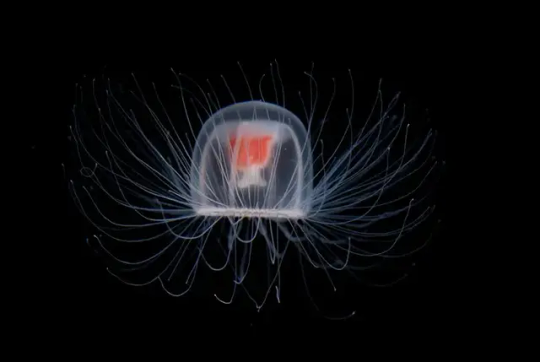
No, the name isn't poetic. Here's Turritopsis dohrnii.
So what does that mean, exactly? The word "immortal" is used in biology to indicate when an organism's cells don't hit Hayflick limit- the point where they can't divide into daughter cells because of DNA damage and/or shortened telomeres. We don't fully understand all the elements at play here, as science is still trying to crack the "formula" for aging and what starts/stops it. This little guy gives us an interesting glimpse at some possible mechanisms at play in all the eukaryotic species out there (like us!).
It is so teeny tiny. They only reach about 4.5mm (less than a 5th of an inch) at full size. That's like the size of the nail on your little finger. So itsy bitsy teeny weeny.
First documented in the 1880s in the Mediterranean, T. dohrnii start out as larvae called planula. The planula then turns into a polyp colony on the sea floor. These polyps develop into the adult medusa stage AKA the jellyfish shape we all recognize (AND LOVE)
When injured or malnourished, an adult can revert back to the polyp stage and start over again. The new adult medusae are genetically identical to the original adult. This isn't the same as asexual reprduction like you see with ferns or hydras. Immortal jellyfish grow to sexual maturity and reproduce via fertilizing eggs with sperm. But they can revert to a sexually immature stage after already reaching sexual maturity. They're the only animal species we know of that can do that!
Okay, but how the hell do their cells pull it off? It's a rare process called transdifferentiation. You know how stem cells eventually develop into different specialized tissues for various purposes? Transdifferentiation turns already specialized cells- typically a permanent situation- into other types of specialized cells. It's very efficient for recycling cells/cell matter. Scientists are researching this mechanism and its implications for the world of medicine. The development of medical applications for this is still in its infancy, but in lab studies, artificially induced transdifferentiation has turned mice liver cells into beta cells (and then we did the human equivalent), and certain mice ovary cells into teste cells. Perhaps in a few hundred years, medical transition options could include performing literal alchemy on your gametes to home-grow your own HRT. It's wild to think about the implications of this.
A scientist at Kyoto university, Shin Kubota, kept a T. dohrnii colony under study for several years. He reported that during a two-year period, his colony rebirthed itself 11 times.
The immortal jellyfish is depicted (very adorably) in the 2020 Halloween Google Doodle as one of the bosses you fight. Legitimately one of my favorite games, check it out!
Photo: Takashi Murai/The New York Times Syndicate/Redux
#marine biology#Jellyfish#wcf#weird creature feed#wcotd#weird creature of the day#Marine Wildlife#Where is my sci-fi about high tech alchemical transmutation transgenderism#I'm going to be thinking about this all day#cohost archive
3 notes
·
View notes
Text
A little independent research:
Jellyfish (Cnidaria Medusozoa) are gelatinous zooplankton characterized mainly by their medusa phase, consisting of free swimming bodies, umbrella-shaped bells, and trailing tentacles often equipped with complex sting cells. Similarly, due to their lack of specialized systems such as a hub for osmoregulation, respiration, circulation, and no nervous system, as well as the fact that they are composed of approximately 95% water, jellyfish have been credited as one of the simplest forms of marine animals. However, in the 1980s biologists discovered the Turritopsis Dohrnii and its close relative Turritopsis Nutricula, which would subsequently be coined as the immortal jellyfish, thus changing the way we view mortality and influencing how we research both the aging process and fatal diseases in humans.
The Journal ``Molecular Phylogenetics and Evolution” further delves into these notions regarding the immortality of Turritopsis Dohrnii and its relatives, exploring the Complete mitochondrial genome and evolutionary analysis of such jellyfish— Key morphogenetic features of jellyfish include tissue and cell differentiation, irreversible cell cycle arrest and final cellular commitment, however, Turritopsis Dohrnii was the first metazoan containing the sequence of the mitochondrial genome that allows it to revert its ontogeny. Although the complete mitochondrial genome has not been reported and analyzed, the complete sequence of the genome is presented. This was achieved by DNA extraction, PCR amplification, and sequencing which allowed for the Organization, structure, and nucleotide composition of the Turritopsis Dohrnii mitochondrial genome to be explored. Furthermore, these reversions in the lifecycle have generated broad interest in this species as a potential biological model for research on aging and the molecular mechanisms of cell differentiation and transdifferentiation.
Additionally, the article “Bioinformation” regarding the conserved mitochondrial gene distribution in relatives of Turritopsis Nutricula, similarly explores these concepts— using phylogenetic analysis on available 16s rRNA gene and protein sequences of Cytochrome oxidase subunit-I (COI or COX1) in Turritopsis Nutricula, additional close relatives with potential immortality are discovered: Nemopsis bachei could be closest organism based on COX1 gene sequence, T. Dohrnii may be designated as the closest taxon to T. Nutricula based on rRNA, and four other species showed similar root distance based on COX1 protein sequence. The COX1 gene is especially important as it's used for phylogenetic analysis, while COX is associated with the process of aging and therefore immortality in these jellyfish. Moreover, with the discovery of related species to the immortal jellyfish, and the presence of the COXI gene, these specific organisms can be a great tool in cancer, aging, and neurodegenerative-related disorders.
Lastly, the paper “Jellyfish, Aging, and Cancer” similarly exemplifies the growing importance of immortality in the specific species of jellyfish— Turritopsis Nutricula and Turritopsis Dohrnii are some of the known hydrozoans in the animal kingdom that can revert back to the polyp stage after reaching the medusa stage of maturity and mating. This process, known as transdifferentiation, is the closest phenomenon to immortality on the planet. Although research on this narrow topic is just beginning, the immortal jellyfish could one day cure aging effects and possibly cancer.

0 notes
Text
#aFactADay2023
#906: you've probably heard of the immortal jellyfish, Turritopsis dohrnii (formerly T. nutricula). it's able to escape natural death by reversing its life cycle, transforming from the medusa back to the polyp, escaping the usual death that post-reproduction medusae suffer. this is known as "ontogeny reversal". it's the first animal known to be able to revert to a juvenile morph after achieving sexual maturity. however, so far this has only been observed in the lab. the observed triggers for it were a change in temperature, a change in salinity, starvation or "mechanical damage" (which i think is ScienceSpeak for "we poked it with a pair of tweezers").
0 notes
Text
Jellyfish can cheat death?
As mentioned by Beck et al. (2018), nature study is “not just our ability to name plants and birds, to ‘know our neighbors,’ as significant as that might be, but the opportunity to question and grow, to be moved, to be momentarily stunned–or flummoxed–by something you couldn't have anticipated”. It has the power to mesmerize and inspire us with the beauty and complexity it has to offer. As someone who loves spending a significant amount of time exploring our world, I have realized that many amazing things about nature often go unnoticed. In this blog post, I will be sharing the most amazing thing I know about nature which hopefully will excite you to go outside and explore!
Jellyfish are amazing and I remember being fascinated by them when I used to watch SpongeBob but did you know that there is a species of jellyfish that can essentially live forever? I know right, I was shocked too! Well, this species of jellyfish is called Turritopsis dohrnii and they originated in the Mediterranean Sea but now are present in many different oceans! I know, this sounds like it's straight out of a movie but it’s a real-life phenomenon and I’ll explain this process to you in more detail!

When faced with adverse conditions, such as starvation or injury, these jellyfish have the unique ability to transform their adult cells into immature cells, which can develop into new polyps, and eventually into new jellyfish (Natural History Museum, 2022). This process is known as transdifferentiation, which allows these jellyfish to cheat death and continue their life cycles indefinitely (Natural History Museum, 2022). Imagine if we could harness the power of transdifferentiation and apply it to our own cells! Imagine if we could regenerate our damaged tissues, organs and even effectively reverse the aging process. Creating awareness about these jellyfish can open up new avenues for research into regenerative medicine and potential for human longevity!
In the future, I hope that these jellyfish will be introduced to public aquariums where people can come and view these amazing creatures! Since I have so much knowledge of this species I would love to be an interpreter at the aquarium where they are introduced. Introducing these jellyfish to an aquarium will allow for more interpretation to take place as these types of places attract many visitors (Beck et al., 2018). Not only will it allow individuals to become more aware that these fascinating creatures exist, but it will also allow them to interpret their life cycle in their own way. For example, to me this species is more than just a jellyfish that doesn't die, they are a symbol of resilience, endurance and strength. Others might follow the same train of thought or they might connect to the jellyfish more by interpreting their life cycle in their own way (Beck et al., 2018). I'm interested to know, what does their life cycle symbolize to you?
Immortal jellyfish are one of the most amazing things about nature but remember, it is just one example of the incredible complexity and diversity that is present in the natural world! The world is filled with so many other fascinating phenomena and creatures that are waiting to be discovered by people.
References
Beck, L., Cable, T. T., & Knudson, D. M. (2018). Interpreting cultural and natural heritage : for a better world. Sagamore Venture.
National History Museum. (2022). Immortal Jellyfish: the secret to cheating death. https://www.nhm.ac.uk/discover/immortal-jellyfish-secret-to-cheating-death.html.
0 notes
Text
I would pick... T. dohrnii's ability to physically revert to a child when life gets too stressful
if you could have any 1 of any animal's ability, what would it be?
mine would be the super loud "SHLOP SHLOP" sound dogs do when licking themselves
5 notes
·
View notes
Text
Rosh Hashanah 5783
I had an unfortunate encounter with a jellyfish in the ocean off Rockaway Beach when I was about eleven years old. I was there with my parents. (I was still too young to understand just how totally uncool it is to go to the beach with your parents.) The day was hot. The sky was blue. And the late-August Atlantic was lovely: salty, briny, and cold. I was in deep-enough water to swim and was focused on trying to do the crawl the way we had been taught at camp when I suddenly felt this intense stingy sensation on my calf. I wasn’t sure what to make of it, but then I saw a whole school of jellyfish—or whatever the right word is for a crowd of them—in the water nearby and heard people on the beach yelling to people in the water to get out. I didn’t need to be told twice. In the end, nothing too bad happened. My calf swelled up and was sore and painful for a few days. Eventually the swelling went down and my leg stopped hurting. I did not go back into the ocean that season. So the episode concluded not badly, but I was left with what by now surely qualifies as a life-long aversion to jellyfish. When we heard on the radio that about twenty billion meduzot were headed for the waters off of Israel’s Mediterranean beaches last summer, we just turned the car around and headed back to Jerusalem to swim in the lovely municipal pool in East Talpiyot that day instead. Problem solved!
So why, as Rosh Hashanah is almost upon us, am I reminiscing about my childhood encounter with a jellyfish? You may be surprised. Or maybe not: it might depend on how diligently you read the Science Times section of the paper that comes out each Tuesday, because last week that section of the Times featured a story that was truly remarkable to consider as we approach the High Holiday season. And it’s about, of all things, jellyfish.
And, at that, not even a full-sized model, but a miniature version correctly called Turritopsis dohrnii. And they really are tiny, each one about the size of a lentil. Mostly, they behave like the larger models. They float around and use their dainty tentacles to bring even tinier sea creatures like plankton to their tiny mouths. But these teensy-weensy creatures can do something that, apparently, no other known living thing can do: when they become old and brittle, or when their bodies become damaged, they have the almost unbelievable ability to morph back into their adolescent selves. They lose their tentacles, then somehow attach themselves to an underwater rock (or something) and begin to develop. When they’re ready, they start out life again as youthful jellyfish. And although they are not invulnerable or indestructible, they do seem to be able never to die of old age.
I wrote to you about Turritopsis dohrnii a full decade ago (click here) when these apparently immortal creatures were first identified. But now, ten years on, scientists have finally decoded enough of the creature’s genome to begin to understand how this minuscule blob of whatever it is jellyfish are made of can possibly be the sole creature on earth that need never succumb to old age. Scientists at Kyoto University in Japan, for example, have managed to create a whole colony of these creatures and to extract enough genetic material to begin to map out their genetic backstory. (For a hysterical look at the lead scientist dressed up as a jellyfish and performing a song he wrote about his immortal jelly-friends, turn up your volume and click here.) Parallel research teams are at work in Spain at the Universidad de Oviedo and here in the U.S. at Texas A&M University in Galveston. The obvious point of all this interest in these tiny things can be summed up in one single and simple question: can we learn how to rework the human genome so as to mimic T. dornhii and thus make it possible for human beings too to skip the whole senescent frailty thing and just hit reset instead? Now how cool would that be?
Even better than Hollywood-style time travel that magically turns people back into the seventeen-year-olds they once were, altering the human genome in the manner that beckons to the scientists mentioned above would permit us to rejuvenate with our memory banks intact, thus offering us the best of both worlds: the bodies of healthy young people combined with the wisdom acquired over the decades we’ve all spent since we were actual teenagers. It’s hard to imagine a more desirable combination!
Or would life absent its awful brevity be something entirely different, something less good, less desirable, less precious? Does the prospect of growing old terrify or ennoble, unsettle or energize? If we knew we could turn back the clock again and again, thus living in our personal versions of the movie Groundhog Day—would that stimulate or paralyze us as we made our way through the years? My first inclination is to say that I would love to shed my current body and turn back into my nineteen-year-old self…and particularly if I was able to hold onto all I’ve learned since I was that age. But there’s another part of me that thinks otherwise, even that knows otherwise. It’s the passage of time that, above all else, stimulates us to action, reminds us to get to work, frames the whole concept of purposeful enterprise. (This is what Andie McDowell inspires Bill Murray to understand in the movie.) Knowing that we don’t have forever is what gets us to make peace with people we’ve wronged or who have wronged us…and it’s also what stimulates the urge to create and to do good in the world.
If we are fortunate enough to grow wiser as we grow older, we can then hope to gain the sure footing we all truly need to be ourselves in the world and to do the good we were meant all along to do. I used to fear the whole concept of growing older. But now I feel at peace with my age, with my stage, with who I’ve become. And part of that acquiescence has to do with also being at peace with the aging process. I don’t wish I were a jellyfish, not even an immortal one. (And for so many different reasons!) But I’ve made my peace with my own mortality and feel driven into the future by the fact that, unlike T. dohrnii, the time I’ve got is the time I’ve got and there ain’t no more. I am therefore impelled—even inspired—to do with it what I can! No more, perhaps. But also no less.
And that is the message I wish to share as Rosh Hashanah approaches. None of us relishes the thought of being evaluated in the heavenly tribunal by Judge God and found either worthy or wanting. And, equally surely, no one wants to take too seriously the notion that we shall all be written up in God’s great book in the course of the coming weeks. But regardless of whether we focus on that model of divine judgment or not, the bottom line is that the years slip by like dreams through sleep and none can halt the flow. (T. dohrnii is surely meant to be the exception that proves the rule.) As we prepare for the High Holiday season, therefore, the idea is not to be weighed down, let alone paralyzed, by remorse or regret regarding the past, but to be energized by the brevity of life to seize the time we do have on this earth to do good, to be kind, to seek justice, and to mend the tears in the fabric of society as best we can. None of us has forever. Therefore, best to get to work!
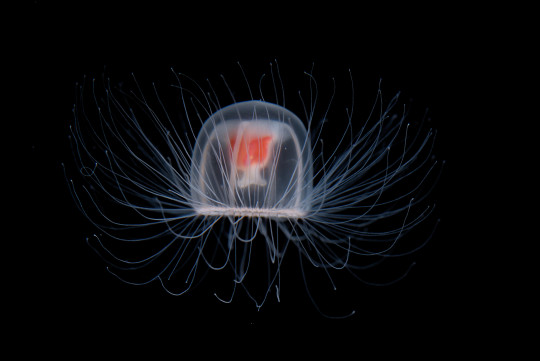
0 notes
Text
I don’t even like jellyfish.
1 note
·
View note
Photo

This is the result of my friend asking me about the immortal jellyfish T. dohrnii. After the following nerd out, she drew Terry. I’m in love with it.
#this is precious#you can fight me on this#t. dohrnii AKA the immortal jellyfish#All Hail Terry#also look at her handwriting it’s amazing#ugh I love this so much
1 note
·
View note
Note
HELLO FELLOW JELLYFISH FAN I SAW A RAMBLE and I am physically incapable of not butting in so please don't mind me.
YES YES YES, you're so right. Jellyfish don't have a brain but do um. things. thanks to a neat little thing called a "nerve net" (in box jellyfish, they actually have a more sophisticated nervous system lovingly called a "Rhopaliar Nerve Network (RNS)"). Technically the same thing as "all nervous system" (though there seems to be different "classes" of nerve nets serve different purposes, there's a fascinating article here by Takeo Katsuo and Ralph J. Greenspan if you want to learn more)
Are you talking about planula?? I love planula! We really need more planula love here, haha. Their exact shape can (naturally) vary by species, but really they can attach onto anything as long as its sturdy enough. Some deep-sea jellyfish lack a polyp stage but those who do often attach onto hard-shell organisms (The Pandea conica or Paper Lantern Jellyfish, however, attaches onto Sea Angels- how cool is that? Here's a picture of her:

I'm SO glad someone mentioned how energy efficient jellyfish propulsion is (like, it's literally the most efficient in the animal kingdom!)- and box jellyfish in particular are known for being the fastest jellyfish (the Chironex fleckeri can swim up to 5 knots :>. I don't know what that is in miles or km tho). It's thanks to a little flap they have on the underside of their bell- I forgot what it was called though. If you ever find a box jellyfish washed up on the beach, you can hear it "whistle" as air flies through that flap
youtube
Tbh I don't actually know what causes spawning but I was going to chalk it up to temperature, haha. Did you know that you can induce polyps to strobilate, though? It's usually by temperature and good conditions, but certain groups of jellyfish (Discomedusae and Cubomedusae) can be induced with indole compounds as well. But uh, strobilation is a little misleading for cubozoa because they actually metamorphize from a polyp straight to a baby cubomedusa (some, like the Morbakka virulenta are an exception, and exhibit monodisc strobilation :>. Heehoo). This is rly interesting though, I might have to look up jellyfish breeding season (god, is this like, the equivalent of jellyfish porn or something? /j /this hurt to write)
I can't remember where I read it (it was probably a japanese translated book or article), but it had one of the best explanations of polyps that I've read. It basically went something like "If we compare cherry blossoms to polyps, cherry blossoms produce fruit like polyps produce jellyfish, but the polyps and trees will still continue to make fruit/jellyfish throughout the year.
Box jellyfish can be "aged" by examining their statoliths (gypsum stones that are located under the rhopalia). A new layer is added every day, so biologists use them to determine age (the average lifespan of a box jellyfish is about 3 months, if I remember correctly). Other jellyfish live around a few months to up to two years in captivity though :>
Did you know the person (Shin Kubota) who sustains the longest colony of T. dohrnii's would go onto tv shows and sing songs about the jellyfish at the end? It's not really jellyfish related and it's information available on the Wikipedia but it's really wholesome. I think we need more people like that in the (jellyfish) scientific community
Hello fellow jelly lover!! Autism be encouraged, I would love nothing more than to hear your hyper-fixation rant on jellyfish!! Kicking my feet and twirling my landline cord B*)
Hi hello did you know that jellyfish have no brain? They are simply all nervous system and move around by electrical propulsion. Literally just vibing, no thoughts head empty.
The study of jellyfish is called medusology because jellyfish are actually only a stage in their life! They start out as larva with essentially a dot of glue on their heads and lil tentacle feet (called cilia) which they use to feed with (their mouth and their anus are the same thing lmao). They float around until they find a good solid surface to glue their head to and become a polyp (related to sea anemone and coral)! While a polyp, they feed with their feet and generally just chill for years.
Polyps produce asexually, where they strobilate (aka split apart like mitosis), and sexually, which is where jellyfish comes in!! The polyp splits apart into medusa (jellyfish) which is essentially the polyp’s gonads/sexual reproductive organs! Jellyfish are just floating uteruses/testicles!!!
No one is sure how long they stay in the medusa stage, but most jellyfish are either male or female and will spawn aka release eggs/sperm pretty regularly if they’re eating enough. Jellyfish eat passively as they swim, which is arguably the most energy-efficient swimming method in animals ever. Spawning is controlled by light (?!!) and they all spawn at the same time of day (again, no brains!! Only vibes).
The polyp who produced asexually (created the medusas) can live for many years, producing medusas each year. Jellyfish? Can live for an unknown amount of time. One species, Turritopsis dohrnii, is essentially immortal because it can transform from the medusa stage into a polyp again, essentially never dying.
Anyways. Jellyfish are so fucking cool!! Nature is crazy! I love the ocean and all it’s alien life!!!
#i had NO idea medusology was a thing but i'm LIVING for it#.professor jellyfish speaks#jellyfish#i honestly have a whole lot more I want to say but i should really stop typing and do. life things#thanks for the original ramble though op!! you're a legend :>#Youtube
14 notes
·
View notes
Text
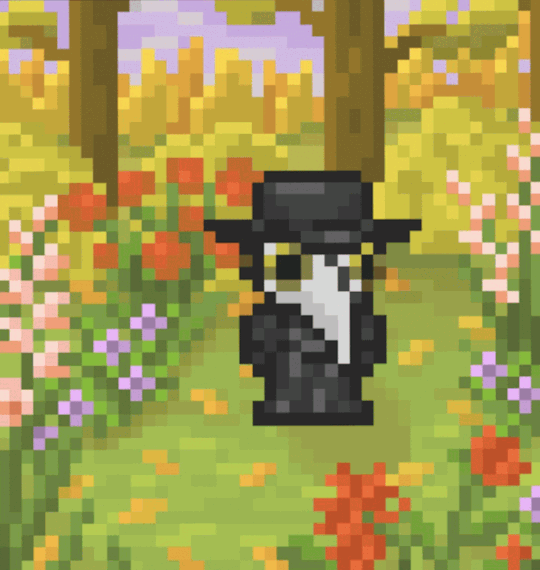
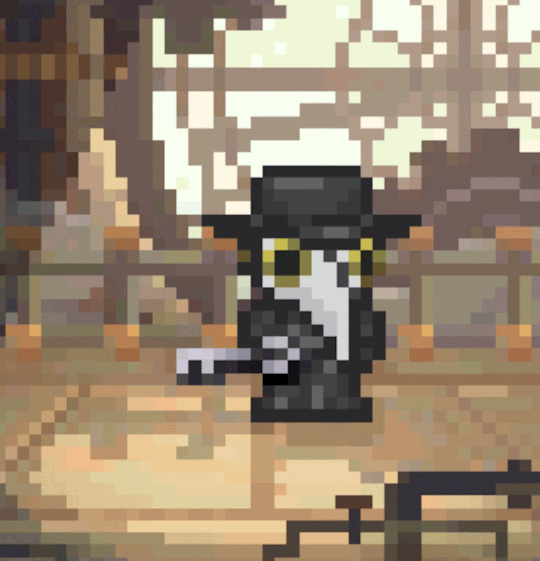
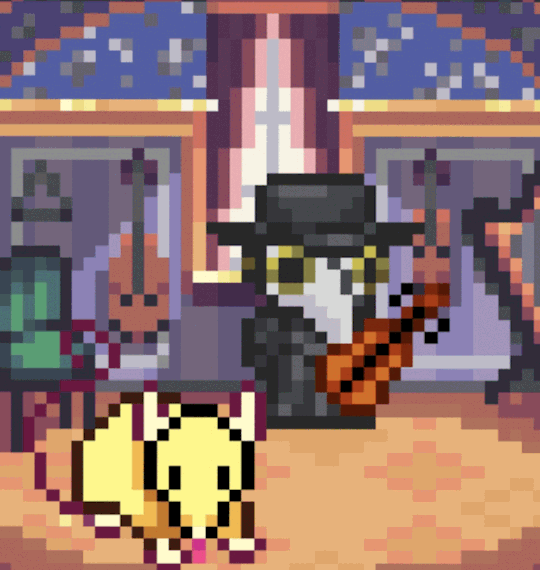
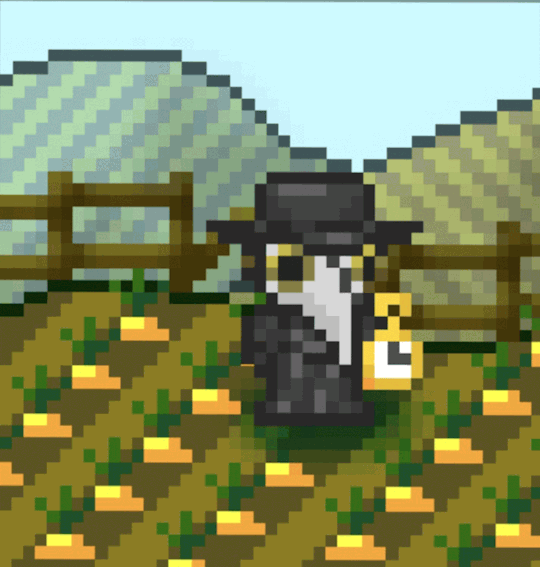
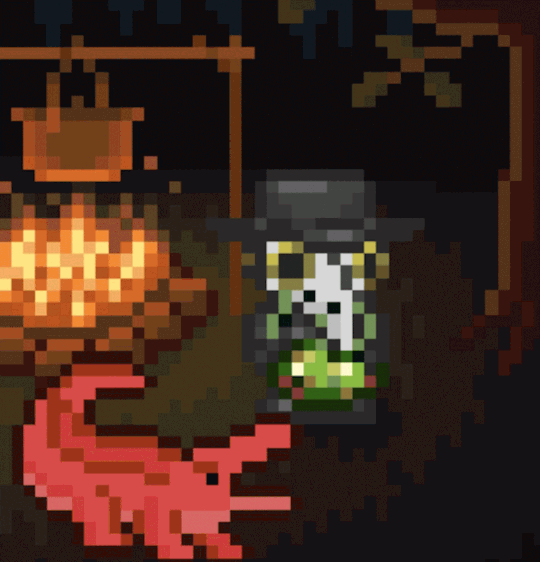
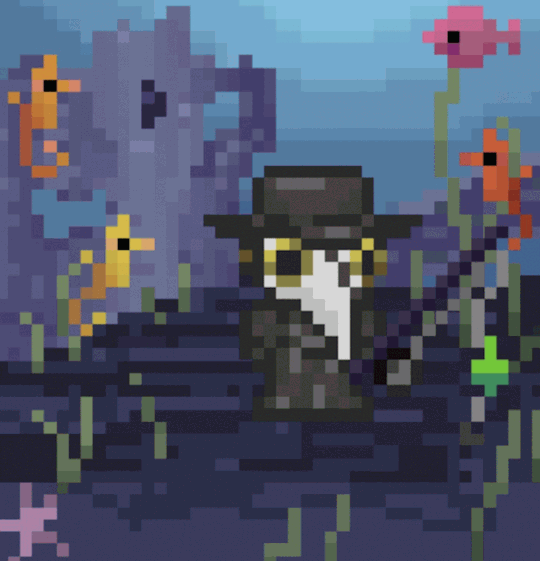
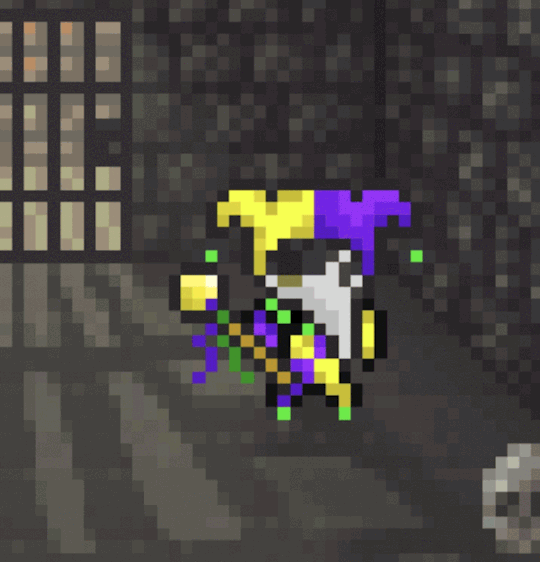
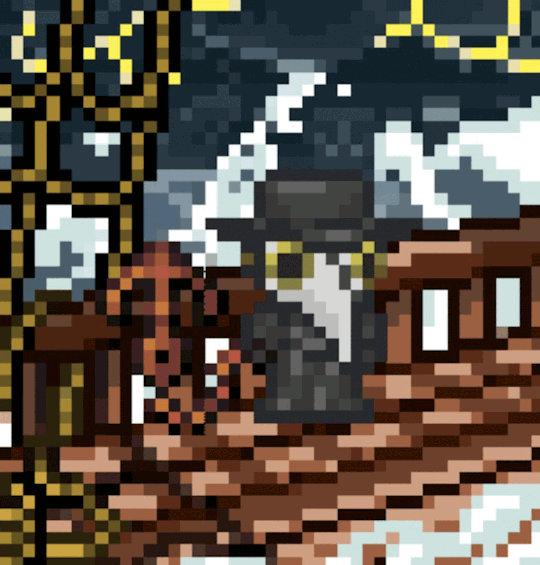

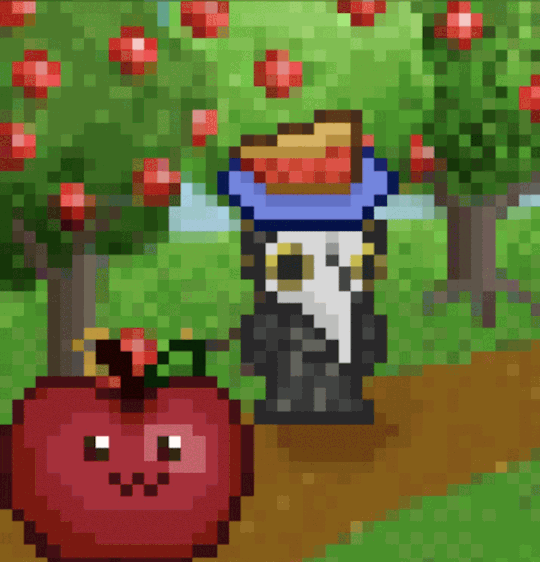

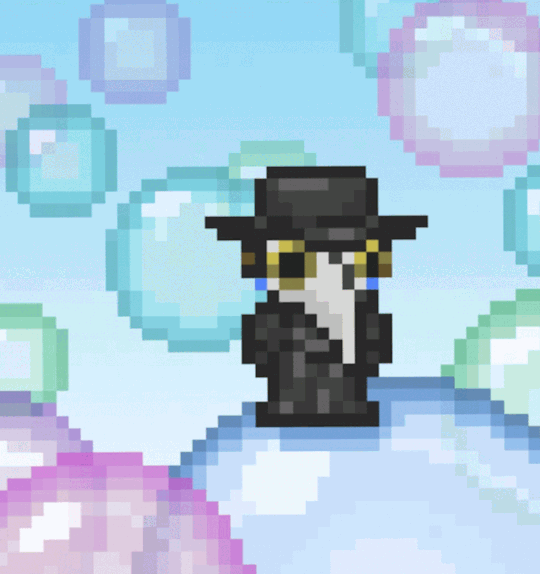
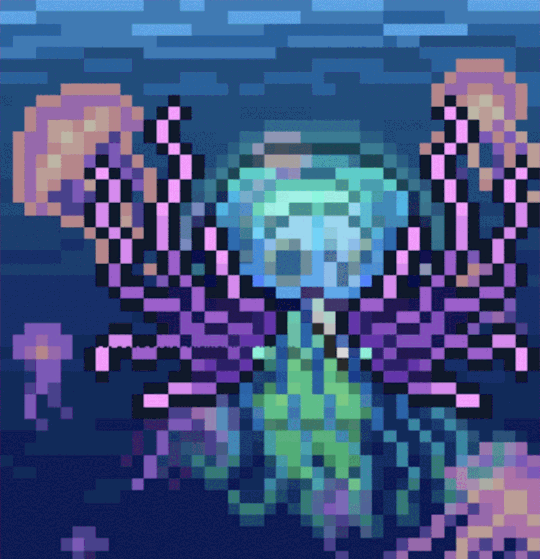
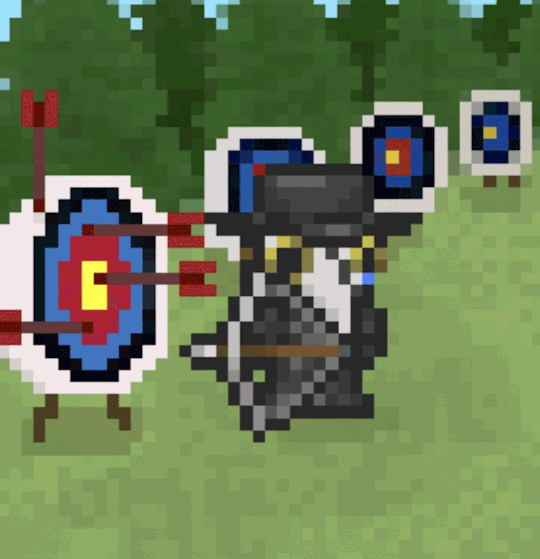
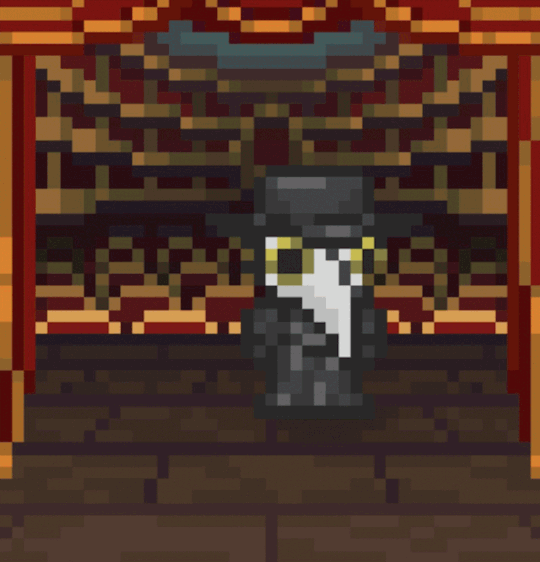
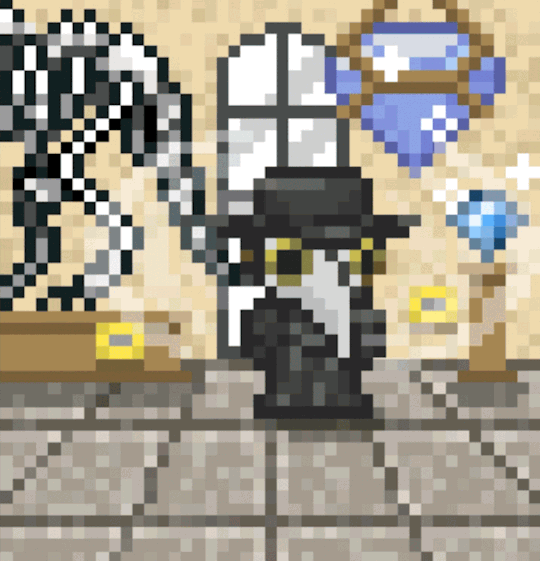
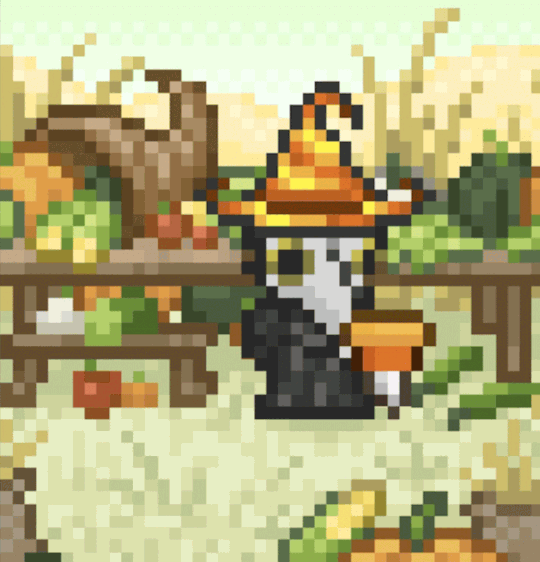
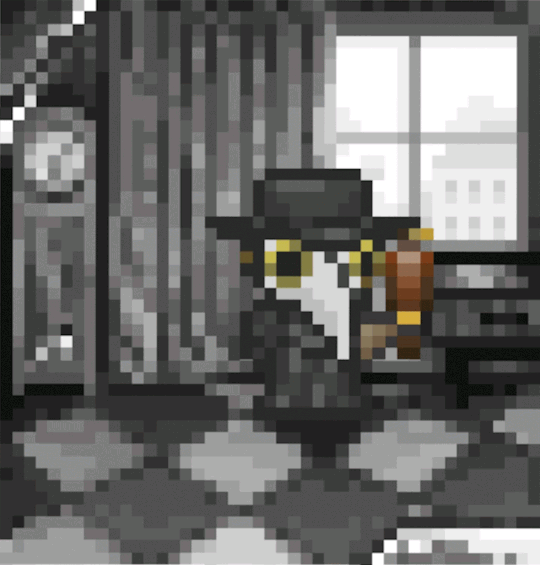
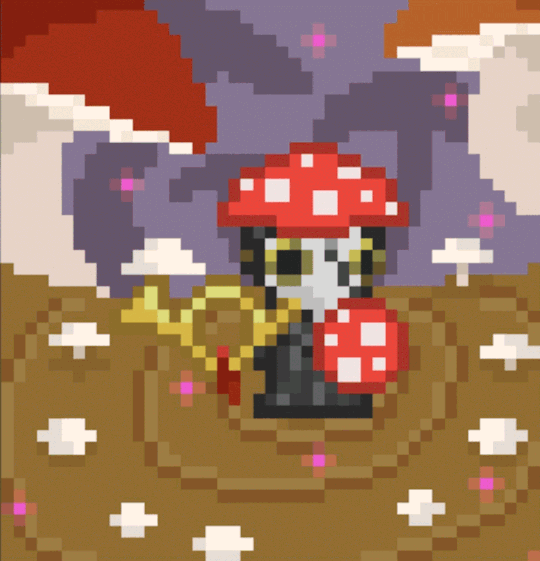
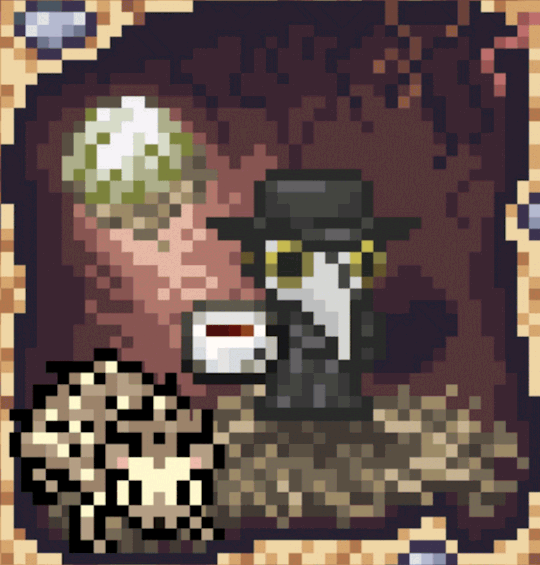
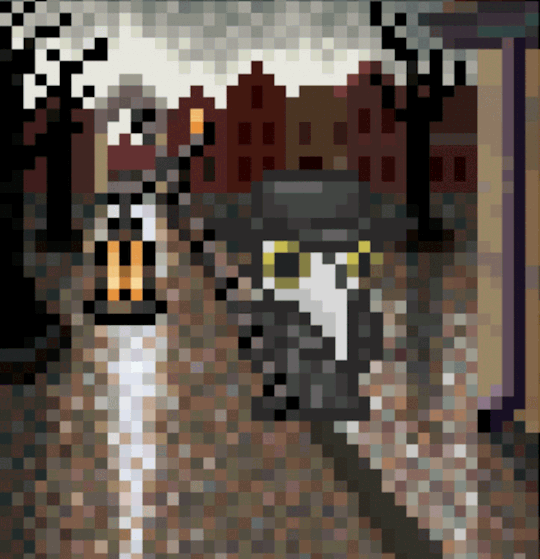
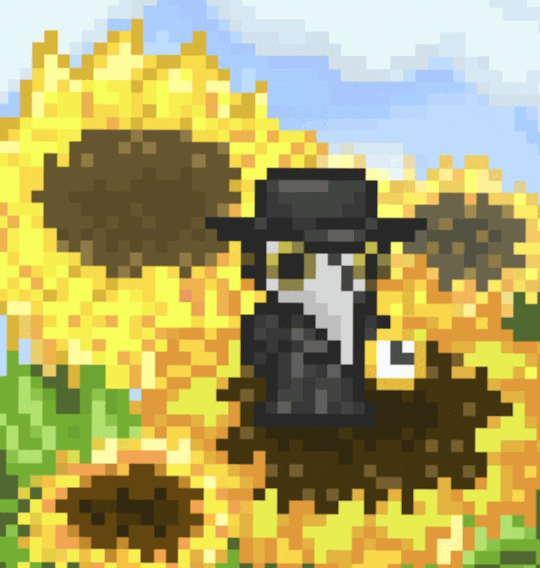
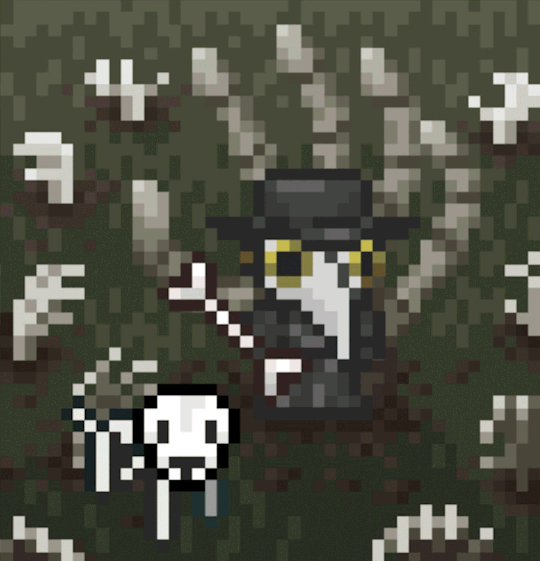
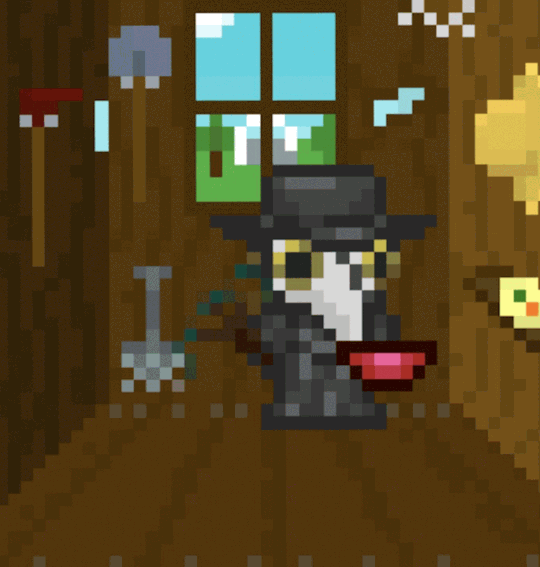
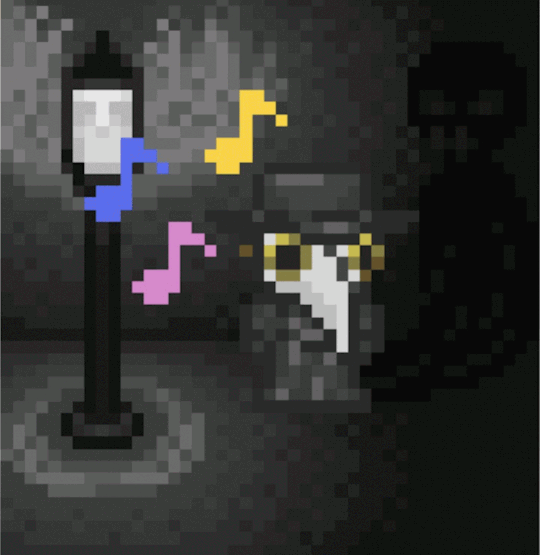
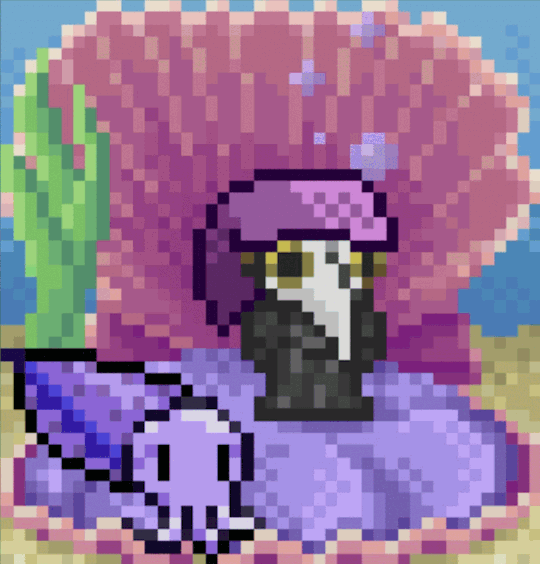

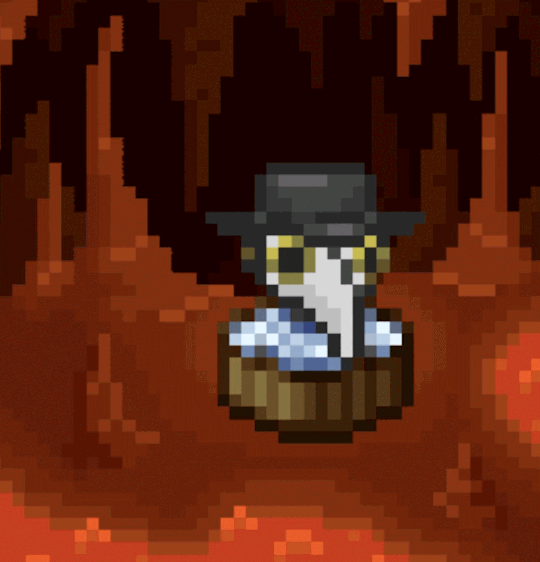
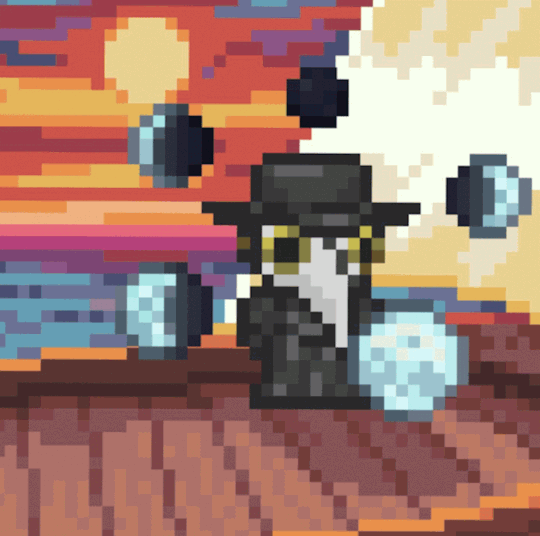
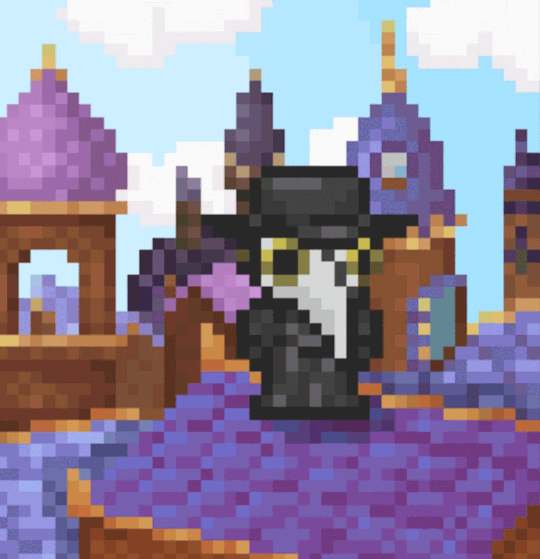
Plaguetober 2022 GIF roundup! Final GIF can be found here. (Have to link due to Tumblr image number restriction). Prompt list by the extremely excellent @plaguefairy. Captions below the readmore. (All credit to the original pixel art asset creators over at @habitica.)
Plaguetober Day 1: Garden -- Nothing could exceed the intentness with which this scientific gardener examined every shrub which grew in his path: it seemed as if he was looking into their inmost nature, making observations in regard to their creative essence, and discovering why one leaf grew in this shape and another in that, and wherefore such and such flowers differed among themselves in hue and perfume. Plaguetober Day 2: Key -- Dr Athanasius considered himself an unofficial steward of the old mechanism, though it involved a considerable climb, requiring much stealth, ever since he first obtained the key. Plaguetober Day 3: Familiar -- Whenever Dr Athanasius took up any of his instruments, Her Abdicated Former Majesty the Erstwhile Queen of Sweden (Erstwhile for short) was always sure to come running. Plaguetober Day 4: Clover -- This is number eight, and the doctor’s at the gate… Plaguetober Day 5: Rotten -- It might smell terrible to you, but it’s undeath-sustaining ambrosia to my hungry little friend here.
Plaguetober Day 6: Find -- After a bit of tricky fishing, he finally found it: The elusive Bone White Hippocamp! Her playful sea-horse woos her soft commands/Turns his quick ears, his webbed claws expands/His watery way with waving volutes wins/Or listening librates on unmoving fins. Plaguetober Day 7: Jester -- In prison cell and dungeon vile/Our thoughts to them are winging. When friends by shame are undefiled/How can I keep from singing? Plaguetober Day 8: Knot -- Now dash’d upon the billow/Our op'ning timbers creak/Each fears a wat'ry pillow/None stop the dreadful leak/To cling to slipp'ry shrouds/Each breathless seaman crowds/As she lay/Till the day/In the Bay of Biscay, O! Plaguetober Day 9: Conundrum -- When one finds oneself in a sticky situation, it can sometimes be advisable to transform one’s foe from an adversary to a steed. Plaguetober Day 10: Pie -- The venomous apples of the outer peninsula required some careful handling, but their flavor was truly beyond compare.
Plaguetober Day 11: Reveal -- I draw down/The open eye/That helped me see/Through the disguise. What’s concealed/Becomes revealed/And I am free.
Plaguetober Day 12: Circle -- Omnia nodis arcanis connexa quiescunt.
Plaguetober Day 13: Everlasting -- If the T. dohrnii jellyfish is exposed to environmental stress, physical assault, or is sick or old, it can revert to the polyp stage, forming a new polyp colony. It does this through the cell development process of transdifferentiation, which alters the differentiated state of the cells and transforms them into new types of cells. Theoretically, this process can go on indefinitely, effectively rendering the jellyfish biologically immortal.
Plaguetober Day 14: Impale -- In retrospect, perhaps Dr Athanasius should have ascertained that the range was clear before attempting to collect his arrows. Plaguetober Day 15: Play -- Govern these ventages with your fingers and thumb, give it breath with your mouth, and it will discourse most eloquent music. Plaguetober Day 16: Reminiscing -- Dr Athanasius in the Musaeum Kircherianum in Collegio Romano, the place of his creation, depicted next to the innermost segment of the speaking trumpet from which he had been lately disconnected. Plaguetober Day 17: Maize -- Dr Athanasius suddenly realized that he had gone all-in on precisely the wrong sort of corn for the Autumn Festival and strove quickly to obliterate the evidence of his faux pas. Plaguetober Day 18: Crime -- The cheaper the crook, the gaudier the patter. Plaguetober Day 19: Jovial -- Fly agaric didn’t tend to have quite the same effect on Dr Athanasius as it had on others of his acquaintance, but he enjoyed the occasional nibble just the same. Plaguetober Day 20: Awaken -- I was only wakened when I had reached the last light sleep which dissolves of itself, and it must have been very light, for it was an almost inaudible whistling noise that wakened me. Plaguetober Day 21: Chatter -- Ordinarily, Dr Athanasius thought of himself as a sort of elevated flaneur, creeping along the rooftops of the city, the chatter and hum of its citizens in his ears. But occasionally he walks the streets themselves, on those rare wet nights when the city is quite, quite empty and quite, quite still. Plaguetober Day 22: Lost -- Try as he might, Dr Athanasius could not reconstruct the plans for his Father’s sunflower clock. The secret to its mechanism seemed to have been forevermore lost. Plaguetober Day 23: Greet -- Dr Athanasius’s reanimated lion adored taking walkies in the Lichgate of the Belimbed, because there he always found a friendly hand to greet him, pat him, throw his bone, and offer him skeletal scritches. Plaguetober Day 24: Cobweb -- Once his friends the cobs were done with them, Dr Athanasius collected their webs for use in his armamentarium. They were particularly useful for staunching excessive bloodflow. Plaguetober Day 25: Melancholy -- Whenever Dr Athanasius felt a bit down, he pulled out his trusty copy of D'Urfey’s Pills to Purge Melancholy, and his heart was immediately lighter. Plaguetober Day 26: Rest -- You wouldn’t think a 17th Century automaton would dream, but you probably wouldn’t think a candle would stay lit in a giant clamshell either. Plaguetober Day 27: Sheet -- That old sheet that Dr Athanasius had stumbled across turned out to have some unexpected properties. Plaguetober Day 28: Cabinet -- Dr Athanasius inherited several things from his Father’s renowned Cabinet of Curiosities, among them the Ira Dei Dragon Balloon and the (slightly singed) Vesuvius Basket. Plaguetober Day 29: Embark -- Fortified by a draft of Cosmiel’s celestial liquor, Dr Athanasius prepares to essay the heavens. Plaguetober Day 30: Music -- Since his disconnection from his speaking trumpet, Dr Athanasius has lacked the power of speech, but from his perch atop the ramparts of the city, he strives always to embody the principles of the Musurgia Universalis. Plaguetober Day 31: Goodnight -- And so the Dr Athanasius who lives in dreams – perhaps only in dreams; perhaps not – bids farewell to him that has harbored him.
#plaguetober2022#plaguetober#plaguefairy#habitica#8-bit paper dolls#dr athanasius#kircher's automaton#plague doctor#plaguecore#plaguesona#plague doctor mask#kircher's automaton dreams 8-bit dreams
31 notes
·
View notes
Text
Immortality exists – but to get it, you need to be a jellyfish, not a god or a vampire. Moreover, only one species of cnidarian, Turritopsis dohrnii, is known to have found the secret of eternal life. Geneticists hope comparing T. dornii’s DNA with its close relative, T. rubra, will help us understand the aging process and how to evade it.
4 notes
·
View notes
Note
Btw, just had a small idea- I'd say it in the discord but I don't have discord lmao, but what if the principal was the typical really old guy and it was a t. dorhnii? So everyone says to not mess with them cause they have seen everything- literally lmao
I just really love the immortal jellyfish
Oooh that'd be a fun idea!
(Theoretical) Immortality in jellyfish is a VERRRRY neat concept. In scientific literature, it's usually referred to as "ontogeny reversal" (ie. Life Cycle reversal)- and it's actually been observed in a handful of other species as well! (with varying degrees of success).
We look to the Turritopsis dohrnii as the "immortal jellyfish" because either I think it was the first one we found to have the trait, or because it was the one with the most reliable ontogeny reversal (other species of the Turritopsis genus are capable of the phenomenon, but the T. dorhnii was able to do it with a higher rate of success)
Anyway, I'd be damned if I went through this game without exploring the concept of reverse ontogeny at least once, hehe.
#gAH I CAN'T SAY TOO MUCH WITHOUT SPOILING SO I HOPE YOU'LL FORGIVE ME FOR DANCING AROUND THE TOPIC#just know that a lot of other jellies are capable of reverse ontogeny but only in the early stages of their life#anyway#yea#lmao#jellyfish#mun rambles#this concept is so cute tho i love it#ask
7 notes
·
View notes
Note
Thank you for answering my ask. You talk about how faunus would be exploited for "medical miracles" and I thought of one particularly insane scenario. Tell me how crazy do you think the mega rich and the scientific community would get over a faunus with biological immortality of the Turritopsis dohrnii AKA immortal jellyfish? We have an individual who returns to a younger state when old, severely injured or sick and could potentially live forever as long as they are not outright killed.
You’re quite welcome!
A Faunus based on T. dohrynii is what I would call theoretically interesting, in that it hinges on whether or not it’s possible under the constraints of RWBY’s lore.
And that, in turn, depends on the degree to which RWBY is married to realism.
Wall of text inbound, because I am a massive nerd.
Jellyfish are, in a manner of speaking, simple organisms when compared to other animals. Cnidarians are the sister clade to bilaterians (all animals with bilateral symmetry), which makes them one of the oldest lineages of metazoans on the planet, excluding ctenophores (comb jellies), protozoans, and poriferans (sponges). Their bodies are a hydrostatic skeleton composed of mesoglea, a transparent jelly-like tissue. More than 95% of their mesoglea is water. They lack specialized systems for respiration and circulation—oxygen literally diffuses from the water right into their bodies. They have a single opening that directly allows food and waste to pass through their gastrovascular cavity, effectively making this opening both a mouth and an anus.
The reason why I mention any of this is because I’m not sure it would even be possible for a jellyfish Faunus to exist, let alone do something like transdifferentiation.
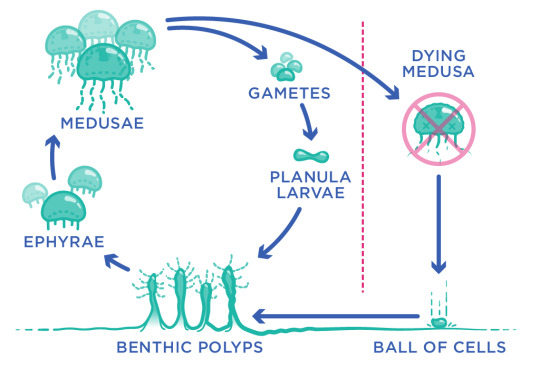
The lifecycle of T. dohrynii, as it depicts transdifferentiation. | Source: The Australian Academy of Science.
In the case of T. dohrynii, “immortality” is a bit of a misnomer, because these jellyfish can die to predation. What actually happens is that the jellyfish, when exposed to environmental stress, physical assault, old age, or sickness, can revert back to the polyp stage. It does this through a process called transdifferentiation, in which mature, differentiated cells can transform into a different type of mature, differentiated cell, without first having to return to an immature pluripotent state.
I have to wonder if the reason why this trait is so rare in nature is because it requires the organism to be so simple in the first place. Would an animal as complex as a hominid—a triploblastic vertebrate with over 200 types of differentiated, specialized cells—be able to pull this off without that degree of simplicity?
Given that Faunus are, for all intents and purposes, hominids, would their primate biology be able to even handle that sort of radical alteration? How would that work on an animal whose body is only comprised of 60% water, with the other 40% being organic matter and acellular materials?
Again, this is where “how much does realism matter to your story” comes into play. So: could a Faunus based on an immortal jellyfish exist?
The answer is yes, absolutely—provided your audience is willing to suspend their disbelief, and your story leans more heavily on fantasy than science fiction.
(In which case, yeah, I can picture the sort of scenarios that a Faunus with that trait would be dealing with. And they wouldn’t be pretty. If they’re smart though, they would try to pass themself off as human, or lie about what their trait is, in order to avoid drawing the attention of the medical community. Otherwise, they’d be getting harassed to participate in academic studies. And for the record, that’s the best case scenario.)
#asks#hivemind42#faunus#i speak#for the record the redux isn't going to have any faunus with cnidarian characteristics#but oh my god could you imagine the poor bastard who has this trait#every bio lab on remnant with grant money would have this dude's address and phone number#they'd be constantly sending letters or leaving voicemails to try and convince them to participate in their studies#hey come volunteer for our ethically-dubious clinical trials#just sign right here#don't worry you don't need to read over the other 102 pages#that's just legal nonsense#definitely not you signing away the rights to your organs#biology
2 notes
·
View notes